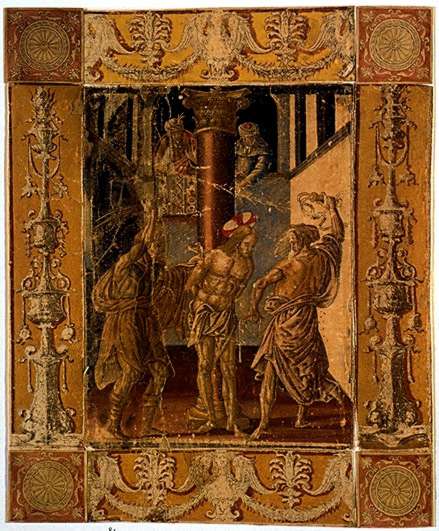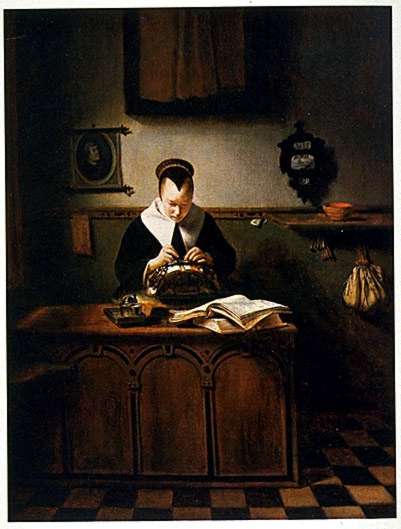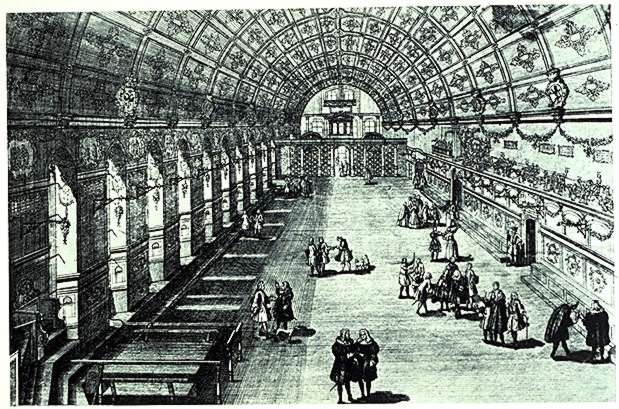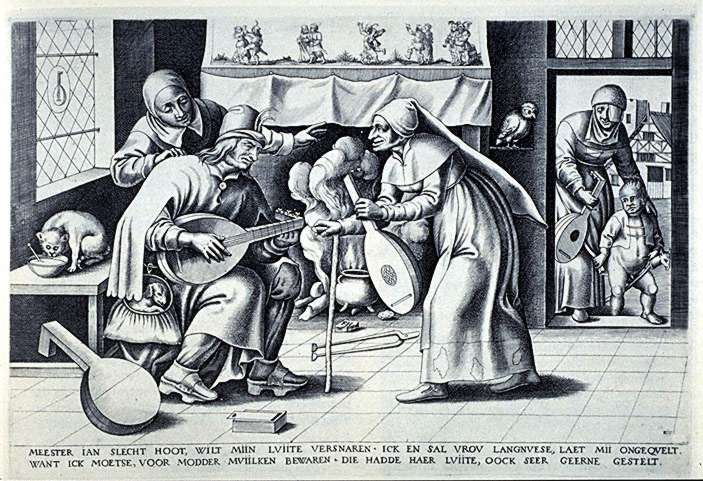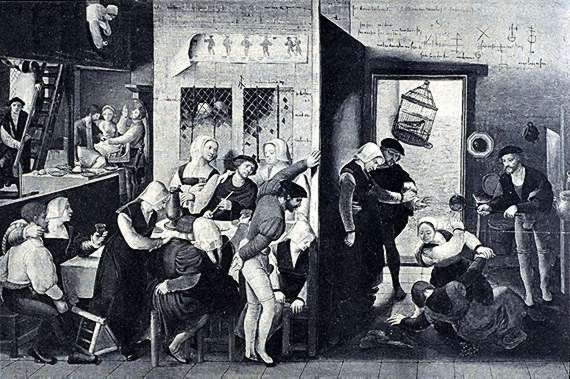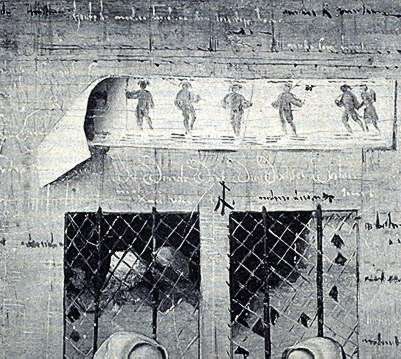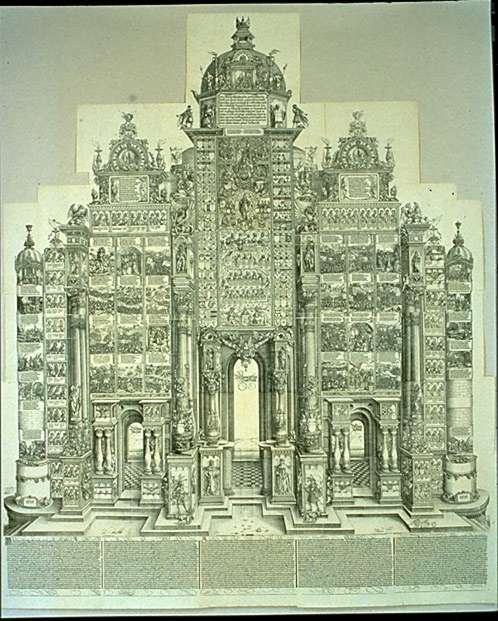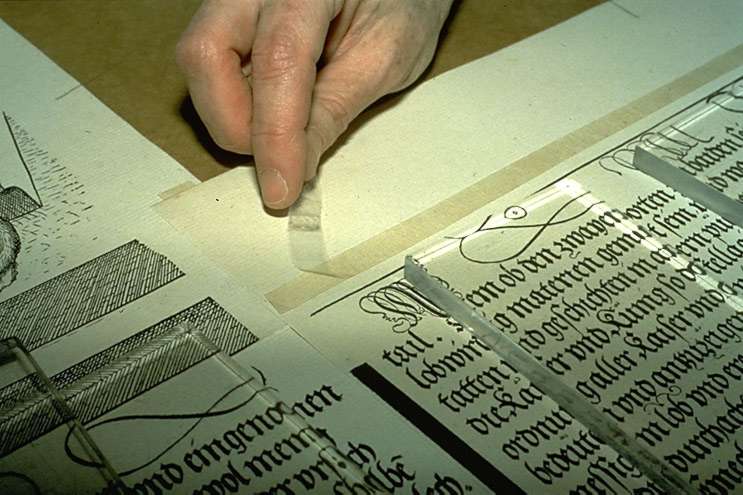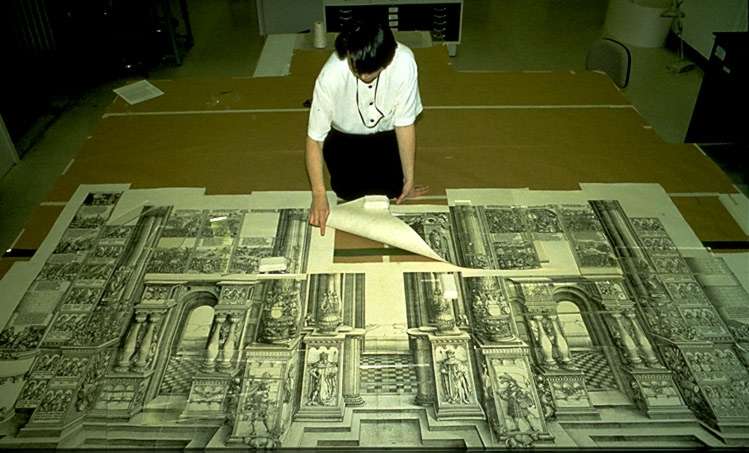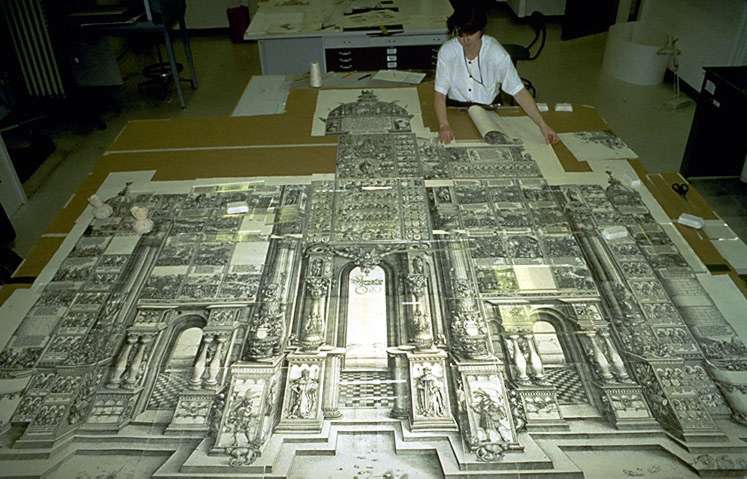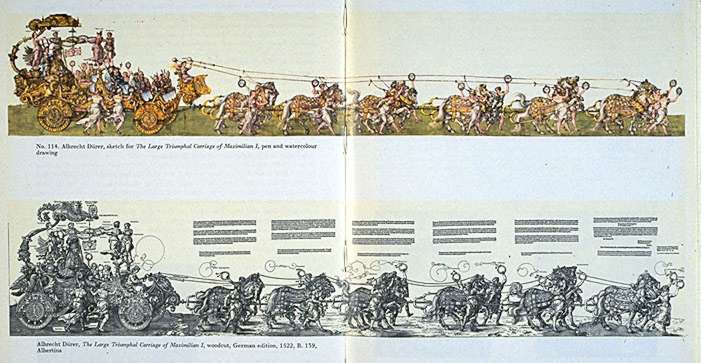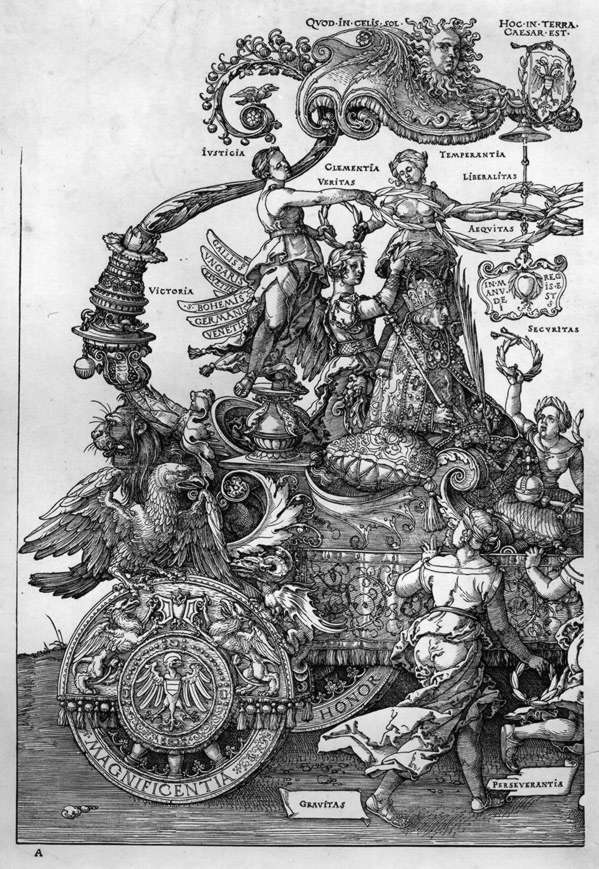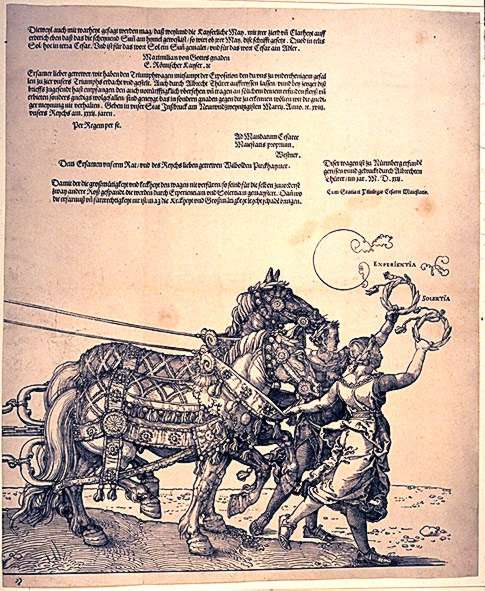The Triumphal Arch and the Large Triumphal Carriage of Maximilian I: Two oversized, multi-block, 16th-century Woodcuts from the Studio of Albrecht Durer
by Linda S. Stiber, Elmer Eusman, and Sylvia AlbroAbstract
The recent mounting of the Triumphal Arch, and the treatment and mounting of the Large Triumphal Carriage stimulated research relating to the art historical origin and function of these monumental prints. Being truly enormous in scale, the Arch alone, when assembled, measures eleven feet, eight and one half inches in height, by nine feet, eight inches in width. The Carriage is of exceptional length, measuring one and one half feet in height, by eight feet long. Maximilian's objectives in commissioning such a grandiose printing project are various. In his selection of the greatest German Renaissance artist, Albrecht Durer, to realize this elaborate program Maximilian secured for himself lasting fame.
Because of the popularity of these prints throughout Europe, even in Durer's lifetime, many editions and copies were printed over the years. Marking the distinctions between the various editions, combined with a knowledge of how the prints were used, reveals aspects of the aesthetic, cultural, and technological conditions in which they were appreciated. This background guides the conservator's judgment in conserving and preparing these oversized prints for exhibition. The following paper is presented in three parts: the origin and display history of monumental prints in general; the execution and mounting of the Triumphal Arch; and the execution, treatment, and mounting of the Large Triumphal Carriage.
Part I: The Origin and Display History of the Monumental Print
Early in the 16th century, Holy Roman Emperor Maximilian I chose the woodcut as a vehicle to mount a public relations campaign aimed at an upper-class audience of leading nobles and imperial officials throughout his empire. The Triumph of Maximilian I was a graphic arts program comprising three gigantic woodcut assemblages: the Triumphal Arch, the Triumphal Procession, and the Large Triumphal Carriage --a work which art historian, Hyatt Mayor called "Maximilian's program of paper grandeur."1 The design and execution of this project materialized over a period of 14 years, between 1512 and 1526, and resulted in the production of 192, 137, and 8 woodcuts for the Arch, Procession, and Carriage respectively. The truly monumental scale of these compositions was unprecedented, and reflected the reputation of Maximilian I, the House of Hapsburg, and the Holy Roman Empire. Intended to represent Maximilian as a latter-day Roman Emperor, the ambitious project engaged the inspiration of a philosopher, an architect, and an historian/astronomer, in collaboration with artists and blockcutters who were supervised by Albrecht Durer.
How did Maximilian come to select the woodcut as a means of securing lasting fame? Maximilian could not have failed to appreciate the propaganda potential of a monumental, six-block woodcut entitled the View of Venice . This unparalleled Venetian publication promoted the fame of the wealthy and thriving seaport. The publisher of the View of Venice, Anton Kolb, was a Nuremberg merchant who, for three years prior, had lived in Venice directing the team of surveyors, the designer Jacopo de' Barbari, and the blockcutters engaged in this project. Both the designer and publisher responsible for this "bird's-eye view" of the maritime city-state entered the service of Maximilian I at Nuremberg in 1500. The precise responsibilities of Jacopo de' Barbari and Anton Kolb, while serving the Emperor, are not known. However it is probable that their expertise in the production of large-scale prints was sought by Maximilian.2 As purveyor of the latest advances in Italian printmaking, from the expansive publishing enterprise in Venice to the burgeoning book and print sellers market in Nuremberg, Jacopo de' Barbari influenced and was admired by Albrecht Durer.
In late fifteenth century Italy the trend in printmaking toward pictorial compositions in multiple scenes had been established by Andrea Mantegna. His Battle of the Sea Gods was the earliest "artistic" engraving to be made from two plates. This technique became the standard device for depicting frieze-like compositions such as triumphs, processions, and battles. Being easily transportable, Mantegna's engravings circulated widely as models of Italian composition and drawing of the human figure. It is quite possible that Maximilian was familiar with Mantegna's nine-plate engraving, the Triumphs of Caesar. The design for this work is reminiscent of the relief of Roman sarcophagi and parallels the contemporary penchant for dramatic street pageants and processionals which featured elaborate floats on wheels and hand-carried banners, plaques, and relics.
Wall Display
At the time that the Triumph of Maximilian I was conceived in the early 1500's, there was considerable precedent for the wall display of prints, whether they were in the form of devotional images, moralities, maps, or simply decorative enhancements.
The wall mounting of prints can be traced back to the informal display of devotional prints on interior walls by means of sealing wax, tacks, or direct adhesion, as illustrated in several 15th- and 16th-century paintings. In the oil panel, Portrait of a Female Donor, 3 painted around 1450 by Petrus Christus, a hand-colored woodcut is attached to the back wall with dabs of red sealing wax.4 The Annunciation,5 a mid-15th-century panel painting by the Master of Flemalle, also depicts a woodcut apparently adhered directly to the mantelpiece.6 In another panel painting dating from 1510-1540, by Joos van Cleve of Antwerp, there is a hand-colored woodcut of Moses tacked to the back wall of this Annunciation 7 scene.8
Fig.1. Scenes from the Life of the Virgin and Christ within borders, mounted on canvas
The wall display of prints is indicated by another 15th- through 16th-century trend --the creation of decorative borders to set off prints. Borders were produced to enhance the presentation of prints in the same manner in which frames enhanced the exhibition of paintings. For example, in the 1470's the Florentine Francesco Rosselli produced a series of fifteen engravings called Scenes from the Life of the Virgin and Christ which were sold with separately engraved borders. The series was often hand-colored and mounted on canvas or wood, presumably as a substitute for the more costly paintings.9 Fifteen canvas-mounted scenes from a complete set belong to the Kunsthalle in Hamburg (Figure 1). A Nativity scene from the series, belonging to the Metropolitan Museum of Art, is mounted on a wooden panel. Rarer still is the Metropolitan's uncut sheet of engraved borders for dividing the vignettes of the fifteen-print series.10 A later example consists of an uncut sheet of colored woodcut borders, created by Erasmus Loy around 1550-1560.11 The sheet is printed in light brown and black, with the white paper reserve functioning as a design element.12 The practice of framing prints within complementary paper borders for wall display is not far removed from the 18th-century vogue among European nobility for mounting prints in print rooms.
Fig. 2. Diagram for assembly, Carta Marina
Related to the development of monumental, multi-scene or multi-section prints was the pre-existing tradition of map making in several sheets. Conceived on a mural-scale, these maps were intended for wall mounting. In fact, the Carta Marina of 1525, was published in Strassburg by Lorenz Fries with "instructions [on] how to glue the map on linen and how to make the pages fit".13 The instructions were complete with a diagram showing how the twelve sheets were to be organized according to letters printed on each page (Figure 2). Early descriptions of the mounting of oversized paper compositions are rare. The translation of these instructions is quoted here in full.
If you want to mount the map yourself and glue it, take linen cloth or a piece of clean old linen sheet and put a broad board on a table or chest and stretch the sheet firmly with nails hammered in all around. After that cut the pages along the left side so that they fit each other. The middle sheets, aa etc. must be cut off also lengthwise. You should try their fit before you start to glue. After that put some glue, but not too strong, into a little pan. Warm it up, but not too hot. Then take a brush, not too small and with soft bristles. Put the pan on the board on which you have stretched the linen and then take the first sheet, labeled a. Turn it around and brush the back with glue and put it on the upper left hand, the way one writes a and then b. Have somebody around to hand you the pages so that you can put them on fast and so that they fit immediately. Then put a clean paper over it and rub it with a piece of cloth so that it is smooth... Particularly cut the bbb sheet to the left exactly to the coat of arms.14
Fig. 3. The Lace Maker
There exists abundant visual documentation of wall-mounted maps. For instance, the paintings by Jan Vermeer--so evocative of 17th-century domestic interiors--often feature wall maps as backdrops. Evidence indicates that prints too, were pasted onto fabric or paper and suspended. This is the method apparently used to hang the portrait print between dowels located to the left of the sitter in a painting by Nicolaes Maes of 1655 entitled The Lace Maker 15 (Figure 3).
Adhesion onto wooden boards also made the wall-mounting of oversized prints possible. Not surprisingly, few examples of such works survive to the present day due to their inherently destructive supports. However, an 18th-century processional print honoring Clement VI, attached to an approximately nine foot-long wooden panel, was recently encountered by a colleague in an antique dealer's shop in Spoleto, Italy.16 Significantly, the print was discolored very dark brown and was stained by liquids.
Fig.4. "Christ flanked by angels," woodcuts on ceiling in Wienhausen Cloister
Mural attachment of large prints also could be managed by direct application to walls, or even ceilings, in the fashion of early 16th-century wallpapers patterned with engraved or woodcut designs. Recall the woodcut fixed to the mantelpiece in the panel painting by the Master of Flemalle, which forecasts this straightforward, yet ephemeral approach. Nonetheless, woodcuts depicting a bust of Christ flanked by two angels from about 1587 still decorate the recesses between the ceiling moldings in a room in Wienhausen Cloister, near Celle, Germany17 (Figure 4). A second room in the Cloister has a 1564 wallpaper, with simplified Moorish design motifs, applied to the ceiling.18
Corresponding to an expansion in size and compositional complexity, oversized prints became more competitive with paintings. This tendency is well illustrated by a richly hand-colored, thirty by seventy-four inch woodcut from around 1560, entitled Procession of the Doges 19 by Jost Amman. When exhibited vertically, the composition of a monumental woodcut or engraving could be viewed as a whole. In The Renaissance Print, David Landau muses on the greater aesthetic role afforded these oversized works and states that "prints were being transformed from objects of devotion to objects of admiration."20
Maximilian's Objectives in Commissioning the Monumental Prints
Fig. 5. Rathaus (Nuremberg Town Hall)
What did Maximilian I actually expect to do with these gigantic, mural-scale woodcut productions? According to Adam Bartsch, Maximilian's correspondence during 1518 documents his "desire and detailed plan to publish a large, allegorical 'Triumphal Procession' which could grace the walls of council chambers and great halls of the empire, proclaiming for posterity the noble aims of their erstwhile ruler."21 In fact Durer's design for the Great Triumphal Carriage functioned as a model for a mural painting commissioned for the Nuremberg Town Hall. The mural deteriorated badly over the years. However, in an 18th-century engraving of the interior of the Town Hall by Johann Adam Delsenbach, the Triumphal Carriage mural is visible on the right wall above the wood paneling (Figure 5).
Printed in limited editions, The Triumphal Arch was to be bestowed on members of the privileged class, in whom Maximilian wished to cultivate nationalism. In the early 16th century the sale of the woodcuts was apparently prohibited. In Peasants, Warriors, and Wives , Keith Moxey writes, "When some impressions of the 'Procession' appeared on the open market in the territory controlled by the city of Nuremberg, their sale was considered illegal, and the city council apologized to the emperor for the incident."22
Certainly possession of one or all three compositions from Maximilian's "Triumph" must have been a mark of political and social prestige. Prominent display of these works would have reflected well the distinction of their owners. According to a 1598 inventory of his cabinet, Albrecht V of Bavaria had an impression of the Triumphal Arch assembled and pasted to canvas.23 Pippa Mason notes that in Abraham van der Doort's 1639 catalogue of Charles I's collection, an impression of the Triumphal Arch is recorded to have been hanging in a frame--a very early reference to this form of print display.24 In Nuremberg Castle, a similarly auspicious setting, the Triumphal Arch was described in an account of 1801, to have been attached to 36 wooden panels-- presumably so it could be exhibited vertically.25
Maximilian's sponsorship of the Triumphal Arch, Procession, and Carriage further stimulated the fashion for mural-scale prints in Northern Europe--as the 16th and 17th centuries bear witness to a prodigious number and variety of works in this vein. The following examples afford compelling visual evidence of how some of these mural-scale prints were probably installed in rooms.
Fig. 6. The Lute Maker's Shop
In an engraving entitled The Lute Maker's Shop 26 by Frans Huys, a processional print ornaments the shop's interior while functioning as a footnote on the scene pictured. Arranged in a frieze above the shop fireplace are five couples of dancing peasants which are appropriated from two actual engraved series executed by Sebald Beham in 1537 and in 1546--prints within a print (Figure 6). In The Lute Maker's Shop the Beham engravings appear to be attached directly to the mantel, a placement reminiscent of the woodcut secured to the mantelpiece in The Annunciation by the Master of Flemalle.
Fig. 7. Tavern Scene
Fig. 8. Tavern Scene, detail
The Brunswick Monogamist painted the Tavern Scene27 in the 1540's. Amid the sundry activities of the clientele, and in the company of abundant graffiti, a processional print of mercenary soldiers is depicted peeling from the center top wall. The vocational reference suggests that mercenaries might be among the Tavern revelers. The painting's descriptive detail clearly reveals the print to be directly adhered to, and in the process of detaching from, the wall (Figure 7 & Figure 8).
Collector's Albums and Portfolios
As the connoisseurship of artistic prints grew in the second half of the 16th century, later editions of the Triumph of Maximilian I were sought by collectors and preserved in portfolios or bound volumes. Coinciding with the increasing value accorded to prints, emphasis was placed on safe-keeping, and the line between display and storage blurs. The collector utilized the bound format for preservation, intellectual organization, and aesthetic presentation. The late 16th-century Hapsburg print collection of Ferdinand, Archduke of Tyrol, survives today in 34 albums.28 Aside from three other volumes dedicated to the works of Albrecht Durer, the Triumphal Procession is separately bound.29
As early as the 17th century, margins of prints were often trimmed, with an eye toward decoratively arranging a number of works on a single album page. The print collection of Samuel Pepys, Secretary to the British Admiralty, was compiled in the later half of the century and pasted into albums in this manner.30 The noted collection survives intact today.31 Trimmed prints by Durer and Lucas van Leyden can be seen grouped together, sometimes eight to a page. Oversized prints, such as two-section engravings by Gerard Edelink, were often trimmed and folded horizontally in half to fit the bound format of this collection. More remarkable is a processional print of over 39 feet in length, depicting the Entrance of Karl V into Bologna, which was folded like a concertina and glued to the inside of an album bearing the Hapsburg coat of arms on the cover.32 The album probably belonged to Maximilian II originally, and is from the late 17th-century print cabinet of Michiel Hinloopen.33
Due to shifts in taste during the past 200 years, a great many
old master prints, large and small, have had their margins restored
with the application of false margins made of paper similar to that
of the original print. Often the plate mark will have been imitated
by an impressed or drawn thin line.
False margins are to be distinguished from inlaid prints. The inlay
technique was intended to provide an extension by which a print
could be safely handled, or simply expand its size. It also
permitted viewing of the print reverse and examination by
transmitted light. A sheet of paper, cut with a window slightly
smaller than the print's outer dimensions, was adhered to the
reverse of the print edges. A variation of this approach involved
attaching strips of paper along the reverse of each edge of the
print, thus providing surrounding margins.
Fig.9. Large Triumphal Carriage of Maximilian I, 5th edition, Library of Congress. Before treatment, with inlaid margins.
The technique apparently dates from the mid-17th century. For example, among Antony Griffiths observations on the print collection of Cassiano dal Pozzo, he describes the careful inlaying of the prints. "The albums of prints of the famous Roman collector Cassiano dal Pozzo, which were certainly assembled before his death in 1657, are most beautifully inlaid, and the centimeter of overlap at the back of each print was carefully burnished down in order to avoid the sharp edge of the paper embossing into the print below."34 Additional instances of the early application of inlaid margins to prints can be seen among the Spencer Albums35, which were compiled by the noted Mariette firm in the early 18th century.36 Both previously mentioned inlay techniques were employed in a number of these albums to expand the size of large prints to conform to the dimensions of a double page spread. The inlaid prints are bound into the albums using guards. There is evidence which suggests that the prints were inlaid during the later half of the 17th century, prior to the compilation of the albums.37 A much later application of this technique can be seen in the Library of Congress' impression of the Large Triumphal Carriage of Maximilian I, with the eight sections joined and the whole composition inlaid with calendered, 20th-century paper (Figure 9).
Later modes of print display, as well as storage, are well documented in the conservation literature. The varnishing and framing of prints, the mounting of prints and other works on paper - sometimes with decorative top mounts, the attachment of prints to wooden strainers, the advent of the Solander box and the window mat, all reflect the changing attitudes toward print collecting and connoisseurship.38
The more "enlarged" issues raised by oversized prints challenge the conservator's guiding principle of providing historically sensitive solutions to their preservation and exhibition. The following two essays illustrate contrasting approaches to this problem: approaches which balance sympathy for the period of these monumental prints with sound conservation materials and practices.
References
Carlo James, "Old Master Prints and Drawings--An Art-Historical Survey of Collecting and of Preservation Methods," Conference Papers, Manchester 1992, Manchester, England, 1992, pp. 86-90.
Mark Stevenson, "The Treatment of Prints: A History," Symposium 88--Conservation of Historic and Artistic Works on Paper, Ottawa, Canada, Canadian Conservation Institute, 1994, pp. 133-42.
Mark Stevenson, "Print Restoration in Northern Europe: Development, Traditions, and Literature from the Late Renaissance to the 1930's," Conservation Research 1995, Washington, D.C., National Gallery of Art, 1995, pp. 110-30.
Elmer EusmanPart II: The Triumphal Arch of Maximilian I
Introduction
Maximilian I, known as the "Last Knight", was enormously proud of his ancestry and personal achievements. The ancestors in his envisioned family-tree included Ceasar, Alexander the Great and even Herakles. He counted among his personal achievements the ability to speak seven languages, the knowledge of artillery and the presentation of a chapel to the Order of St. George. He was actively involved in fields like classical archeology, art criticism, music and poetry, veterinary surgery, mining and fashion designing. An impulsive, generous and patriarchal ruler who was constantly short of money, Maximilian was conscious of the grandeur of his house and urged the imitation of the Roman emperors. Like Ceasar, Titus and Constantine, Maximilian was to have his triumphal procession and triumphal arch.
Concerned with ensuring his lasting fame, he lacked the funds to erect an arch of triumph in stone. However, an arch of triumph in the imperial Roman tradition printed on paper was achievable and had two distinct advantages. Apart from being less costly, it could be assembled simultaneously in many locations. This suited the emperor very well since, in the age the upcoming Reformation, he was full aware of the power of printed word and image. A completed arch and procession on paper was then to be dispatched to all the corners of the empire, where all could learn of and testify to the emperor glory.
History of the Arch
Fig. 10.
The first impression of the Triumphal Arch as a busy concoction of imagery, architectural elements and decorative patters, is not strange in view of the involvement of the many artists in its creation (Figure 10).
The architectural design and the arrangement of the gates of the Triumphal Arch were originally conceived by the Tyrolean court painter and architect Jorg Kolderer as a miniature. It was the historian, biographer and court astronomer Johannes Stabius who transformed the idea into a giant woodcut. He provided the content of the imagery and the compositions of the inscriptions. It was the same Stabius who persuaded Dürer to oversee the artistic execution of the Triumphal Arch around 1512. A large part of the design was done by Durers assistants: Hans Springinklee and Wolf Traut. The two round towers flanking the Arch are attributed to Albrecht Altdorfer. The coats of Arms of Kolderer, Stabius and Dürer can be found in the right bottom corner. The end product is what C. Dodgons calls a curious travesty of a Roman Arch, or as Jane Hutchinson notes; "Closely resembling a Nuremberg stove".
The commission was probably given to Dürer in 1512, who must have completed the design of the Arch in 1515, when he applies for payment in a letter dated July 15. The complete print consisted of 192 woodcuts produced by Hieronymous Andrea two years later. In February 1518, Maximilian was able to send a copy to his daughter Margerete in the Netherlands.
While Stabius was paid in May and Dürer was promised payment in September of the same year, Hieronymous Andrea receives no payment for eight years. Finally in 1526, nine years after Maximilian's death, the city of Nuremberg reimbursed the form-cutter for his work. He then gave up all the blocks which until then remained in his possession. From this point on, the blocks traveled to Augsburg, Vienna, Graz, and back to Vienna. Of the 192 blocks 171 have survived and are now kept in the Albertina.
Circa 700, copies were printed within two years of the completion of the Arch. The first edition of the complete Arch was printed between 1517-1518. Approximately 200 sets were printed. The 24th historical panel, that was to be filled with an image of Maximilian's tombe, is still vacant. The second edition was printed upon the command of the Archduke Ferdinand, the grandson of Maximilian in 1526-1528. He requested 300 sets, and gave permission to print additional sets in order to reimburse the printer. The first and second edition are hard to distinguish from one another; they both contain the same watermark and the print quality is equally pristine. Like the first edition, the 24th panel remains empty. A separate print, imaging Maximilian's tomb, was produced to be pasted in the vacant panel. In the third edition, printed upon command of the Archduke Charles, the son of Archduke Ferdinand in 1559, the last panel of the historical scenes remains vacant again.
Two and half centuries later in 1799, the fourth edition was published by Adam Bartsch and printed by T. Mollo at Vienna. This edition is fundamentally different from the first three. By the time of this most recent printing, the blocks show considerable wear and a number of the blocks are missing. The missing blocks were replaced with etchings by Bartsch. These include three of the historical panels: the Battle of Utrecht, Maximilians coronation and the Congress of Vienna. The 24th panel of the historical scenes now depicts the Battle of Pavia, fought by Charles V in 1525. The historical panel, "the Burgundian Wedding" was replaced with an earlier version, attributed to Hans Springinklee, which Durer had found unsatisfactory.
The Content of the Arch
The size of the assembled arch is approximately 3.5 x 3 meters or 11 x 9 feet. The arch is divided into three portals, "Fame" and "Nobility", both flank the center-gate of "Honor and Might". The midsection of the edifice is reserved for the genealogy of the House of Habsburg. The twenty-four panels above the portals of fame and nobility depict Maximilian's political history. The two round flanking turrets show further events and Maximilian's personal accomplishments. Stabius provided a detailed description of these in the legend at the bottom.
The decorations in the arch are a mixture of Christian, heathen and even Egyptian symbolism. Of the three the last is perhaps the most interesting. In the second or fourth century A.D. Horus Apollo composed a work entitled "Hierogliphica" on Egyptian hieroglyphics. Supposedly translated from Egyptian into Greek by one Phillipus the treatise became known in Italy in 1419 and made a big impact in the humanistic world. It is completely worthless from a scientific point of view since the true meaning of hieroglyphics was not known until 1799 after the discovery of the Rosetta Stone. But the elegance of an ideographic language which could express a whole sentence by a series of images, was very appealing to the humanists who always held a fascination for mysterious Egypt. This new language is still known as "emblem literature". Dürer definitely knew of the existence of this new language since he was to illustrate a Latin translation of Hieroglypica by his friend Pirckheimer. Maximilian embraced the latest fashion, supposedly derived from ancient antiquity.
A good example of the use of emblematic language is found in the top tablet where the emperor is surrounded by supposedly hieroglyphic symbols. He is shown sitting on a leaf of papyrus, signifying his ancient lineage; supported by a lion of courage and a bull of power. Visible at the bottom are detached feet walking on water, representing the ability to rise above the impossible.
Treatment
A portfolio containing the fourth edition of the Triumphal Arch was donated to the National Gallery by Mr. David Tunick in honor of the 50th anniversary of this museum in 1991. The donation was made with the stipulation that the Arch was to be assembled and exhibited in the "Dürer to Diebenkorb" show later that year.
After much deliberation the National Gallery decided to proceed with the assembling of the Arch even though it new that this would mean cutting a number margins from the prints. Apart from the stipulation from the donor, motivation for assembling was the fact that this was a fourth edition restrike from 1799, issued by Bartsch. Furthermore a second set of the same edition was promised to the National Gallery which was to remain unassembled. But perhaps most importantly, the original intent of this giant woodcut was to assembled and shown as a whole.
After removing small amounts of surface dirt from the margins, the bottom margin and the left side margin were folded to the back (except for those prints situated at the bottom or the far left of the arch). The sheets were then laid out on a large piece of brown packing paper on several combined tables and benches. Bartsch edition was accompanied by a ground plan for the assemblage of the arch which made this process fairly easy.
The placement of the individual sheets was marked on the packing paper making sure that on average, every sheet fitted reasonably well. Instead of the more traditional wheat starch paste it was decided to use pressure sensitive strips, made from Japanese paper impregnated with a water-based acrylic adhesive, Lascaux 360 HV. Besides being able to disconnect two sheets when they would not fit correctly, the use of a pressure sensitive adhesive would avoid the distortions that a water-based adhesive, like starch, would cause in the completed arch. The Lascaux was brushed unto both sides of Japanese paper and dried on mylar. After the paper, still connected to the mylar, had dried, it was cut into strips of circa 0.5 inch wide. Once off the mylar the Japanese paper strips work as a double sided tape. No heat or even a roller was needed, only light pressure was enough to make two sheets adhere. However, after adhesion the sheets could still be separated and readhered in case of misplacement.
Fig. 11.
Fig. 12.
Fig. 13.
Fig. 14.
The sheet that was to be fitted in the bottom left corner was laid down in its place. Two strips of Japanese paper and mylar were placed on the top and right side margin. The mylar was peeled off (Figure 11) and the neighboring sheet could now be adhered to the first. The complete arch was assembled this way. (Figure 12 and Figure 13) Japanese paper strips were also adhered to the different additions and then placed in its proper places. The arch was assembled in two halves with the dividing line right through the center. This way the two parts could be stored in the large flat files without disassembling the woodcut. A large portfolio was constructed and used to transport the arch to the photography department and later to its final destination. The complete arch was mounted upon muslin stretched around a frame made of lumber. The lumber frame was covered with plywood and 4 ply rag board. The unbleached muslin was washed to remove the sizing. The two parts of the complete arch were hinged with Japanese paper and wheat starch paste. The hinges were adhered to the muslin using PVA. The mounted arch was exhibited in a custom made frame (Figure 14).
Fig. 15.
Returning to the stored arch two years later Linda, Sylvia and myself found the print in fine condition (Figure 15). We found no signs of cockling or discoloration, neither in the prints nor in the margins containing the Lascaux 360.
References
Eckman, Inge-Lise, The Lining of a Super Sized Contemporary Drawing, AIC Preprints, Washington: AIC, 1985.
Kurth, Dr. Willie, The Complete Woodcuts of Albrecht Durer, Crown Publishers, New York, 1946.
Meder, Joseph, Durer Katalog, Verlag Gilhofer & Ranschburg, Wien, 1932.
Panofsky, Erwin, The Life and Art of Albrecht Durer, Princeton University Press, Princeton New Jersey, 1971.
Russell, Francis, The World of Durer 1471-1528, Time Incorporated, New York, 1967.
Scherer, Valentin, Die Ornamentik bei Albrecht Durer, J.H.ED. Heitz (Heitz & Mundel), Strassbourg, 1902.
Scherer, Valentin, The Works of Durer, Brentano's, New York, 1908.
Skeist, Irving, Handbook of Adhesives, Second Edition, Van Nostrand Reinhold Company, New York, 1977.
Strauss, Walter L., Albrecht Durer--Woodcuts and Wood Blocks, Abaris Books, New York, 1980.
Strauss, Walter L., The Illustrated Bartsch 10--Albrecht Durer, Abaris Books, New York, 1981.
Waetzoldt, Wilhelm, Durer And His Times, Phaidon Publishers Inc., Oxford University Press, New York, 1950.
Winkler, Friedrich, Albrecht Durer--Leben und Werk, Verlag Gebr, Mann, Berlin, 1957.
Sylvia Rodgers AlbroPart III: The Large Triumphal Carriage of Maximilian I
History of Design
A Triumphal Procession lead by an Imperial Carriage was meant to accompany the Great Arch, perhaps even ceremoniously passing underneath it. 39 The procession was made up of 57 yards of woodcuts and illustrated the exploits of Maximilian and the subjects of his Empire. Musicians, hunters, members of the court, jousters, and countless other symbols and characters were included in the processional fanfare. The original idea of such a procession to accompany the Arch was the Emperor Maximilian's own, which he proposed in the year 1512 after his final visit to Nuremberg. It was during this visit that he met Albrecht Dürer and viewed the two portraits that the artist had painted for the town hall. 40 The Triumphal Procession, like the Arch was a true group project, involving many advisors and multiple artists, however, the design for the imperial carriage was entrusted to Dürer himself.
Fig. 16. Albrecht Dürer's first drawing for the Carriage, dated 1512, in the collection of the Albertina Museum, Vienna. (Photo courtesy of Koschatsky and Strobl, Dürer Drawings in the Albertina)
Maximilian gave explicit instructions for the design which were followed closely by Dürer in his first drawing for the carriage dated 1512, and now in the collection of the Albertina Museum in Vienna.41 The image (Figure 16)was to include:
"the Emperor in his Imperial garb and Majesty, and according to rank his first Empress, the future King Philip and his Queen, and King Philip's children and Duke Charles shall have a crown on his head"42
Though charming, this first image proved not sufficiently grand to be distinguished from the lengthy Triumphal Procession itself.
Fig. 17. Second drawing by Dürer for the Carriage and first edition woodblock print made after the drawing, both in the collection of the Albertina Musem, Vienna. (Photo coutesy of Koschatsky and Strobl, Dürer Drawings in the Albertina)
Dürer's best friend, the court philosopher Willibald Pirckheimer is credited with the more elaborate allegorical scheme for the Triumphal Carriage which Dürer faithfully depicted in his second design submitted and approved by the Emperor in 1518. The original watercolor, also in the Albertina Museum, shows the Emperor sitting with family members, at the moment of being crowned by Victory surrounded by the Four Cardinal Virtues. (Figure 17)
The carriage is pulled by eight pairs of horses led by allegorical figures who personify additional "statesmanlike or soldierly virtues".43 Pirckheimer's idea was to present "not an ordinary triumph, but one also of philosophy and morality"44 for the Emperor.
Maximilian was pleased with the drawing as indicated in his correspondence with Pirckheimer during the evolution the project :
".....Honorable, dear, loyal subject: We have received the "Triumphal Chariot" with the explanations that accompanied it to demonstrate your loyalty and to adorn our "Triumph." We have examined it carefully and look with special gracious pleasure upon your diligence and devotion..." 45
Maximilian was very interested in the progress of the cutting of the eight large woodblocks for the print series and frequently visited the formschneider (or cutter) Hieronymous Andrae's studio in Nuremberg.
"....this Hieronymous [Andreä] resided in Breite Gasse, in this city, and his quarters extended in the rear to Frauengässlein [i.e. "Women's Alley"]. It was he who cut most of Albrecht Dürer's designs into blocks, amoung them Dürer's "Triumphal Chariot" of His Imperial Majesty. At that time, His Majesty drove almost daily to Frauengässlein to watch his artistry, so much so that it became proverbial that "the emperor has driven once more to the "women's alley." 46
Unfortunately, the Emperor Maximilian died before the project was finished and he did not see the final prints, published as a series four years later, in 1522, by Dürer's studio. In the published prints the Emperor is depicted alone in the carriage rather than surrounded by family, but he is still in the midst of the Four Cardinal Virtues and under the crown held by Victory. An explanatory text by Pirckheimer accompanies the figures.
Art Historical Interpretation
Fig. 18. Andrea Mantegna, Four Muses Dancing, engraving. Collection of the British Museum
Dürer's ideas for the design were not entirely original. J. Meder was the first to point out that Dürer modeled his allegorical figures after the dancing nymphs illustrated in prints by Andrea Mantegna.47 These figures are essentially the translation into the graphic medium of the 'Dancing Muses' from Mantegna's painting Parnassus which now hangs in the Louvre. (Figure 18)
Art historian E. Panovsky describes the Large Triumphal Carriage as being in Dürer's "Decorative Style" strongly influenced by the artist's trips to Venice in 1494 and 1505, where he probably viewed other well known processionals such as those by Titian and Mantegna. Panovsky says " Spatial, plastic, and luminary values are deliberately suppressed in favor of a pattern designed to fill, to diversify, to enliven, in short to adorn a two-dimensional surface rather that to suggest an autonomous three-dimensional picture space. The print has a textile quality like a tapestry of black and silver threads hung on a wall."48
Editions of the Print
That the print of the Large Triumphal Carriage was popular is indicated by the fact that seven editions were published from the original blocks and a number of copies were made by Dürer's contemporaries. Various editions of the print in a number of institutions were examined by the authors in order to distinguish their characteristics and to study their current display format as well as to detect any evidence of previous formats.
Fig. 19. First edition of the Large Triumphal Carriage, Metropolitan Museum of Art
The first edition of the Large Triumphal Carriage was published in Nuremberg by Dürer himself, with the text in German in 1522.49 The Metropolitan Museum of Art has a first edition copy of the eight prints (Figure 19) which show some of the margins of the prints still intact as well as the alphabetical capitals along the bottom edge marking the print order. The printing is not consistent throughout this set, with the last print being rather heavily over-inked compared to the other sheets in the series. An irongall ink inscription "1522" is present on the verso of each of the prints. The prints are currently stored partially assembled, in mats.
Fig. 20. First edition of the Large Triumphal Carriage, New York Public Library
In the New York Public Library's first edition prints, the margins are trimmed closer to the border, but still include the alphabetical markings on the first seven sheets and the eighth sheet has a wider margin which contains the gothic capital letter "H" at the bottom left in Maximilian's personal typeface, which represented the Imperial privilege given to Dürer for making the print. The prints are currently stored in individual mats. (Figure 20)
Fig. 21. Traced watermark from the paper of the first edition of the print
The paper in these first edition prints comes from near Nuremberg and has the same watermark as that used by Dürer for other large woodcuts. 50 (Figure 21)
It is a fine white paper of medium weight, beautifully made with few if any imperfections; ropemarks and felt impression are very evident in the surface texture. Looking at these prints one can observe the imprint of the printing blocks in their original pristine condition, with no wormholes or breaks. There is considerable relief to the lines on these prints. Also, on the New York Public Library prints one can admire what appears to be a chiaroscuro plate-tone effect that Dürer employed in printing this particular woodcut. The legs of the figures and horses which are in the background are selectively wiped, leaving behind what looks like a continuous tone of ink in some areas, giving a three-dimensional quality to the earlier impressions which later editions of the print do not have.
Both the Metropolitan Museum and the New York Public Library prints have been pressed and flattened in a previous treatment. They show evidence of adhesive residues on the edges from a former assembly and old folds from an earlier storage arrangement. The prints were quite possibly once housed in collector's albums. Obviously, the Carriage was smaller in size than the Arch and linear in format which made its storage in an album reasonable and still quite easy to read.
Although many of these prints have been subsequently removed from their original collector's albums, one volume which still contains the Great Triumphal Procession bound in a folded format was located by art historian Peter Parshall in the 16th c. collection of Ferdinand, Archduke of Tyrol. 51
Fig. 22. Second edition of the Large Triumphal Carriage, National Gallery of Art
Another example of the album format still in evidence can be seen in the National Gallery of Art Rosenwald Collection second edition print which is eight attached panels folded into a portfolio which still retains the guard attachment for previous insertion into a bound volume. (Figure 22)
This is a lovely print with intact margins. Quite possibly the Rosenwald print has not been wet out or pressed and therefore retains considerable printing relief and felt impression in the paper texture. A small letter "h" in Roman typeface has replaced the gothic typeface from the first edition on the eighth print in the series. The second edition of Dürer's print was also published by the artist's studio in Nuremberg. It was printed in Latin in 1523 on the same paper with the identical watermark as the first edition.
The third edition in German and fourth edition in Latin of the print are more difficult to find. Some copies of these exist in European collections and their watermarks and typographical differences (as for all editions of the print) are carefully documented by Meder and others.52
The Library of Congress' version of the print is from the fifth edition, published in Venice in 1589 by the German printer Jacubus Chinig. (See Linda Stiber, Figure 9) The blocks are currently in the collection of the Albertina Museum. It is not surprising that there would be a market for this print in Venice where there was a large well-established German community known as the Fondaco dei Tedeschi for whom Dürer had earlier created a much admired work: the painting of The Feast of the Rose Garlands. 53 Dürer's graphic works had also been collected in Italy from very early on. Vasari says:
"This man was so unusual, diligent and versatile that if he had been from Tuscany instead of Germany, and if only he had been able to study in Rome like we have, he would have been the best painter in our lands. Nonetheless he is the most unusual and famous to ever come from the Flemish school....his prints are famous for their novelty and beauty and everyone tries to collect them....54
During the 15th century Venice had established a copyright privilege which encouraged printers to set up shop there and protected them temporarily from copyists. 55 Although some modern art historians don't agree 56 Vasari claims that the purpose of Dürer's second visit to Venice in 1505 was primarily to present his case before the Republic against engraved copies of his prints by the italian artist Marcantonio Raimondi who signed his copies with Dürer's monogram.57 Certainly a vast printing and publishing market flourished in that city, a center of international trade during this period.
Fig. 23. Beta radiograph of the watermark from the Library of Congress print
The fifth edition of the Triumphal Carriage is on a Venetian paper watermarked with an escutcheon and the initials S and G. The paper is also a fine white paper like the earlier editions, but it is slightly lighter in weight. (Figure 23)
Briquet identifies this watermark as 16th century, and the paper from the area immediately around Venice. 58 The blocks were by this time 67 years old. Considering the age and the quite different climates of Nuremberg and Venice, it is not surprising that they show signs of wear.
After Chinig's Venetian print two more editions were made before 1601. The blocks are described in the literature as extremely worn. 59
There were also contemporary engraved copies made by the artist Hans Guldenmund, printed first in 1529, and with two subsequent printings. An example of one of these prints from the Baltimore Museum shows a Dürer monogram in the lower left which is not present on the originals.
Library of Congress Conservation Treatment
The Library of Congress received its print series from the George Lothrop Bradley collection in 1906, and the first print bears his collector's mark in blue ink on the verso.
The entire print had had at least two previous mounts before our treatment. Its current mount was an inlay of eight sections joined together with strips of linen tape. The left edge of the first inlay was creased in the fashion of a book guard for insertion in bound format or portfolio.
The verso of the print still contained residues of shives from a coarse flour paste indicating a former attachment overall to another support. It could be assumed that the print had been wet out fully at least two times: to apply the lining and to remove it. The paper tone had yellowed and the sections were unevenly discolored. Further examination revealed tears with old repairs, small losses, ingrained surface dirt, some skinning and staining, distortions etc... The ink was slightly friable and a small amount transferred to a dry torn blotter lightly touched across the surface.
It was decided to unmount the print from its current arrangement due to the damage actively caused by handling and to try to re-mount it close to the manner in which it was meant to be viewed originally. Evidence of former mounts was saved along with the treatment documentation.
The linen hinges were slit and each section was treated individually. To prevent disturbing the ink any further a float-washing technique was selected using two screens. Each piece was humidified in Goretex® then float-washed in deionized water adjusted to pH 7.5 with calcium hydroxide. After 20 minutes of washing each piece was inverted on a piece of silicone-coated mylar over a light box to remove old mends and residual adhesive. After a brief rinse, pulp fills of linen fiber were used to fill the losses. Afterward, each section was sprayed with a dilute solution of methylcellulose to consolidate the image layer and strengthen the paper. 60
Fig. 24. Library of Congress print after conservation treatment
The sections were dried and flattened under felts, and a template made to aid in positioning them correctly, as all the sections had been trimmed inside the border and none were square. Once positioned, strips of Japanese paper selected to match the thickness of the original 61 were used to fill the missing parts of the sections in the area of join, matching the grain directions of the 16th century paper and using wheat starch paste adhesive. Hinges of lighter weight tissue were attached to the top and sides for mounting. (Figure 24)
The print was attached to an acid-free mount using pass-through hinges pasted to the backing. An eight-ply mat frames the image. The wooden frame is now stored upright. The print was relatively flat in the frame to begin with, but after two years in storage despite reliable climate control, the paper has moved and changed dimension. Perhaps this is something which should not be a surprise to paper conservators!
After looking at so many versions of this print it is easy to develop quite an appreciation for it even though it, like the Triumphal Arch, is panned by many art historians as not being exemplary of Dürer's best work. Panovsky, for instance, calls the Carriage:
"A weighty monstrosity.......with an allegorical spirit which runs to the extreme."62
But perhaps a better measure of the print's success is the fact that it was published so many times and has been repeatedly mounted and displayed and copied. Clearly the print has popular appeal!
Conclusion
When an object such as a work of art on paper is brought to a conservator for evaluation for treatment, there are a number of diagnostic tools at the conservator's disposal, not to mention her/his cumulative experience of observing and recording characteristics of paper and media. Observations such as those only a conservator who has intimate contact with the work of art can make, are essential in determining how an object was cared for or displayed in the past. Although the display history is only one of many aspects of an artwork's value as a cultural object, the evidence of former mounts and formats contributes to the curatorial study of the piece and is fundamental to the conservator's treatment decision-making process. Knowledge of how objects were historically mounted and displayed thus becomes a part of the conservator's necessary body of information.
Acknowledgements
The following people were helpful during the writing, research or conservation work done on behalf of all three authors of this three-part presentation. We are exceedingly grateful to them:
Catherine Bindman, Metropolitan Museum of Art
Katharine Blood, Library of Congress
Marjorie B. Cohn, Harvard Art Museums
Shelley Fletcher, National Gallery of Art
Carter Foster, New York Public Library
Doris Hamburg, Library of Congress
Greg Jeckman, National Gallery of Art
Renate Mesmer, Speyer Archiv, Germany
Margo McFarland, Library of Congress
Connie McCabe, National Gallery of Art
Kitty Nicholson, National Archives
Peter Parshall, Reed College
Mark Stevenson, Private Conservator, Kansas City
Yoonjoo Strumpfels, National Gallery of Art
Judy Walsh, National Gallery of Art
Merrilee Wilson, Library of Congress
Notes
Part I
1. Hyatt Mayor, Prints and People, New York, Metropolitan Museum of Art, 1971.
2. David Rosand and Michelangelo Murano, Titian and the Venetian Woodcut, Washington, D.C., International Exhibitions Foundation, 1976, p. 11.
3. National Gallery of Art, Washington
4. Maryan W. Ainsworth, Petrus Christus, Renaissance Master of Bruges, New York, Metropolitan Museum of Art, 1994.
5. Musees Royaux des Beaux-Arts, Brussels
6. J. R. J. van Asperen de Boer, J. Dijkstra and R. van Schoute, Underdrawing in Paintings of Rogier van der Weyden and Master of Flemalle Groups, Zwolle, Waanders Uitgevers, 1992.
7. Metropolitan Museum of Art
8. The Metropolitan Museum of Art, The Renaissance in the North, New York, Metropolitan Museum of Art, 1987.
9. David Landau and Peter Parshall, The Renaissance Print, 1470-1550, New Haven and London, Yale University Press, 1994, p. 82.
10. Mayor, plates 92 & 93.
11. Braunschweig Museum
12. Horst Appuhn, Riesenholzschnitte und Papiertapeten der Renaissance, Unterschneidheim, Germany, Verlag Dr. Alfons Uhl, 1976, p. 100.
13. Hildegard Binder Johnson, Carta Marina, World Geography in Strassburg, 1525, Minneapolis, University of Minnesota Press, 1963, p. 52.
14. Ibid.
15. National Gallery of Canada
16. Sylvia Rodgers Albro, Senior Paper Conservator, Spring 1995, personal communication.
17. Appuhn, p. 88.
18. The casual tacking or otherwise "sticking" of prints to interior walls apparently continued to be a convenient form of attachment as well. The evidence is visually recorded in prints and paintings up through the 18th century. In Quirin Borin's "The Urine Doctor" of 1658, a print of a drunkard is fixed to the wall on the left (Spencer Album 5, Harvard University Art Museums). In "Extreme Unction," an intimate bedside scene painted by the Venetian Pietro Longhi, a colored print with white margins is secured to the wall beside the dying man (Fondazione Scientifica Querini Stampalia Venice). It is possible that the work is a chiaroscuro woodcut, considering that this printing technique was experiencing a revival in the first half of the 18th century--the same period in which Longhi executed the painting. Finally, in two views of a room in the Palazzo Sessa, where Sir William Hamilton resided as British Ambassador at Naples, a decor is revealed which parallels the fashionable print rooms of the late 18th century (Jocelyn Fielding Fine Arts Ltd). Among a delightful concomitance of natural artifacts, weaponry, Grecian vases, books, and other curiosities, a number of prints, drawings, maps, and paintings ornament the walls--with frames and without. Several of the works on paper appear to be tacked directly to the Rococo style walls. See Peter Thornton, Authentic Decor: The Domestic Interior, 1620-1920, New York, Viking Penguin Inc., 1984, pp. 136-37.
19. Stuttgart
20. Landau and Parshall, p. 88.
21. Walter L. Strauss, Editor, The Illustrated Bartsch, 10 (Commentary), New York, Abaris Books, p. 421.
22. Keith Moxey, Peasants, Warriors, and Wives, Chicago & London, University of Chicago Press, 1989, p. 22.
23. Peter Parshall, Professor of Art History, Reed College, 1995, personal communication.
24. Pippa Mason, "Framing of Prints in England, 1640-1820," Museum Management and Curatorship, v. 1, Butterworth-Heinemann Ltd., 1992, pp. 117-32.
25. Appuhn, p. 97.
26. Rijksmuseum, Amsterdam
27. Staatliche Museen, Berlin
28. Kunsthistorisches Museum and Schloss Ambras, Vienna
29. Peter Parshall, "The Print Collection of Ferdinand, Archduke of Tyrol," Jahrbuch der Kunsthistorischen Sammlungen iun Wien, Wien,Verlag Anton Schroll & Co., 1983, p. 145.
30. Jan van der Waals, "The Print Collection of Samuel Pepys," Print Quarterly, England, v. 1, 4 (December), 1984, pp. 236-57.
31. Magdalene College, Cambridge, England
32. Jan van der Waals, De prentschat van Michiel Hinloopen, Amsterdam, Rijksmuseum, 1988, pp. 72-3.
33. Rijksmuseum, Amsterdam
34. Antony Griffiths, "Print Collecting in Rome, Paris, and London in the Early Eighteenth Century," Harvard University Art Museums Bulletin, Cambridge, Massachusetts, Harvard University Art Museums, Spring, 1994, p. 41.
35. Harvard University Art Museums, Cambridge, Massachusetts
36. Marjorie B. Cohn, A Noble Collection: The Spencer Albums of Old Master Prints, exh. Cat., Cambridge, Massachusetts, Fogg Art Museum, Harvard University Art Museums, 1992.
37. Marjorie B. Cohn, Carl A. Weyerhaeuser Curator of Prints, Harvard University Art Museums, 1995, personal communication. One type of paper was used uniformly to inlay all of the prints that have strip margins, however, the album pages are composed of a different paper. This group, and several prints inlaid with single sheets, were inscribed on the reverse of the prints by Pierre Mariette with late 17th-century dates. The theory that these prints were inlaid prior to the compilation of the albums is further supported by the presence of an anomalous print which was inlaid twice with different papers, one inlay surrounding the other. Finally, one other print is so large that its top edge, including inlaid margin, is folded over, while the fore and bottom edges of the inlay are trimmed even with the album pages.
38. Catherine Hicks, "Early Approaches to the Conservation of Works of Art on Paper," British Museum Occasional Paper No. 65, London, British Museum, 1988, pp. 7-14.
Part III.
39. Die bibliophilen Taschenbücher, Der Triumphzug Kaiser Maximilians I. 1516-1518 (Dortmund: Harenberg Kommunikation); 1979
40. Jane Campbell Hutchison, Albrecht Dürer, A Biography (Princeton NJ:Princeton University Press) 1990, p. 113
41. Walter Koschatsky and Alice Strobl, Dürer Drawings in the Albertina, Translated from the German by Heide and Alastair Grieve (London: Secker and Warburg) 1972, p. 278-280
42. Erwin Panovsky, The Life and Art of Albrecht Dürer, (Princeton, NJ: Princeton University Press) 1971, p.180
43. Ibid.
44. Ibid
45. Walter Strauss, The Woodcuts and Woodblocks of Albrecht Dürer ( N.Y: Abaris Books, Inc.) 1980, p. 536
46. Ibid.
47. Koschatsky, Op. cit. p. 279
48. Panovsky, Op. cit. p. 190
49. F. W. H. Hollstein, German engravings, etchings and woodcuts 1400-1700 (Amsterdam: M. Hertzberger) 1954 , p.203
50. Oberbaurath B. Hausmann, Albrecht Dürer's Kupferstiche, Radierung, Holzschnitte und Aeichnungen, (Hannover: Hahn'sche Hof-Buchhandluns) 1861, no. 32
51. Peter W. Parshall, "The Print Collection of Archduke Ferdinand", in Jahrbuch der Kuntshistorischen Sammlungen iun Wien (Wien: Verlag Anton Schroll and Co.) 1982
52. Joseph Meder, Durer-Katalog (Wien: Gilhofer and Ranschburg) 1932
53. Panovsky, Op. cit. p. 107
54. Giorgio Vasari, Le Opere, Prima Parte (Firenze: David Passigli e Soci) 1832-1838, p. 684 Translation author's own.
55. D. Rosand and M. Murano, Titian and the Venetian Woodcut (Washington, D.C.: International Exhibitions Foundation) 1976, p. 11
56. Hutchison, Op. cit., p. 79
57. Vasari, Op. cit., p. 684
58. Charles M. Briquet, Les FiligranesVolume III (Amsterdam: The Paper Publication Society) 1968, no. 636
59. Meder, Op. cit.
60. Dow Methocel A4C 2% in 50:50 water and absolute alcohol.
61. University of Iowa Kozo Tissue White '89
62. Panovsky, Op cit. p. 180-181
Linda S. StiberSenior Paper Conservator
Library of Congress
Elmer Eusman
Assistant Paper Conservator
Baltimore Museum of Art
Sylvia Rodgers Albro,
Senior Paper Conservator, Conservation Office
Library of Congress
Publication History
Received: Fall 1995
Paper delivered at the Book and Paper specialty group session, AIC 23th Annual Meeting, June 4-1, 1995, St. Paul, Minnesota.
Papers for the specialty group session are selected by committee, based on abstracts and there has been no further peer review. Papers are received by the compiler in the Fall following the meeting and the author is welcome to make revisions, minor or major.
